Plant dynamics analysis of sodium-cooled fast reactors using Flownex code
IF 1.9
3区 工程技术
Q1 NUCLEAR SCIENCE & TECHNOLOGY
引用次数: 0
Abstract
Plant dynamics analysis plays an important role in the design and operation of sodium-cooled fast reactors (SFRs). This paper presents the development and validation of a plant dynamic model for an SFR using the Flownex code, a general-purpose thermal-fluid simulation software. A general modeling philosophy is provided for building Flownex models to simulate key components of the SFR, including the core, plenum, pipelines, intermediate heat exchanger (IHX), and pump. A new user-defined script for SFR kinetics calculations has been developed, which enables neutron kinetics calculations based on the point kinetics model with reactivity feedback effects. The procedures for simulating heat sources, sinks, and the inclusion of temperature-dependent sodium fluid properties are discussed in detail. These models and approaches are designed to optimize execution speed while maintaining good accuracy based on practical experience with the code.
A plant dynamics model is developed for the “Fast Flux Test Facility (FFTF)” reactor using Flownex and is used to simulate the “Loss Of Flow Without Scram (LOFWOS)” test #13. The good agreement observed between the simulation results of various SFR parameters and the experimental data demonstrates the suitability of the Flownex code for advanced plant dynamics studies of SFRs. However, the current system modeling approach has certain limitations, primarily due to the neglect of spatial (multidimensional) effects and the simplified treatment of feedback reactivity components. Potential directions for future improvements are also discussed in this paper.
使用Flownex代码对钠冷快堆进行电厂动力学分析
电站动力学分析在钠冷快堆的设计和运行中起着重要的作用。本文介绍了使用Flownex代码(一个通用的热流体模拟软件)开发和验证SFR的工厂动态模型。为建立Flownex模型提供了一个通用的建模理念,以模拟SFR的关键部件,包括核心,静压室,管道,中间热交换器(IHX)和泵。开发了一个新的用户定义的SFR动力学计算脚本,该脚本可以基于反应性反馈效应的点动力学模型进行中子动力学计算。详细讨论了模拟热源、水槽和含温钠流体性质的方法。这些模型和方法旨在优化执行速度,同时根据代码的实际经验保持良好的准确性。使用Flownex为“快速通量测试设施(FFTF)”反应堆开发了一个工厂动力学模型,并用于模拟“无停堆失流(LOFWOS)”试验#13。各种SFR参数的模拟结果与实验数据吻合良好,证明了Flownex程序适用于SFR高级植物动力学研究。然而,目前的系统建模方法存在一定的局限性,主要是由于忽略了空间(多维)效应和简化了对反馈反应性成分的处理。本文还讨论了未来改进的潜在方向。
本文章由计算机程序翻译,如有差异,请以英文原文为准。
求助全文
约1分钟内获得全文
求助全文
来源期刊

Nuclear Engineering and Design
工程技术-核科学技术
CiteScore
3.40
自引率
11.80%
发文量
377
审稿时长
5 months
期刊介绍:
Nuclear Engineering and Design covers the wide range of disciplines involved in the engineering, design, safety and construction of nuclear fission reactors. The Editors welcome papers both on applied and innovative aspects and developments in nuclear science and technology.
Fundamentals of Reactor Design include:
• Thermal-Hydraulics and Core Physics
• Safety Analysis, Risk Assessment (PSA)
• Structural and Mechanical Engineering
• Materials Science
• Fuel Behavior and Design
• Structural Plant Design
• Engineering of Reactor Components
• Experiments
Aspects beyond fundamentals of Reactor Design covered:
• Accident Mitigation Measures
• Reactor Control Systems
• Licensing Issues
• Safeguard Engineering
• Economy of Plants
• Reprocessing / Waste Disposal
• Applications of Nuclear Energy
• Maintenance
• Decommissioning
Papers on new reactor ideas and developments (Generation IV reactors) such as inherently safe modular HTRs, High Performance LWRs/HWRs and LMFBs/GFR will be considered; Actinide Burners, Accelerator Driven Systems, Energy Amplifiers and other special designs of power and research reactors and their applications are also encouraged.
 求助内容:
求助内容: 应助结果提醒方式:
应助结果提醒方式:


